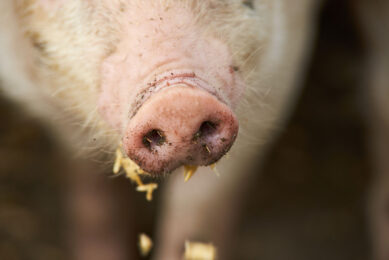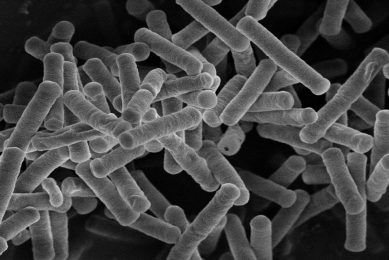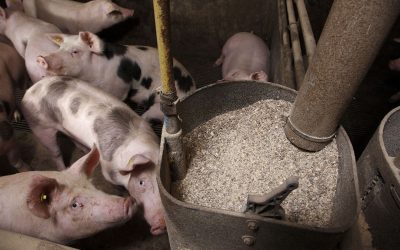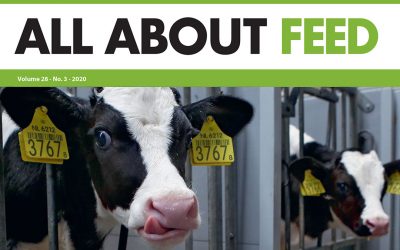Mitigating virus in pig feed
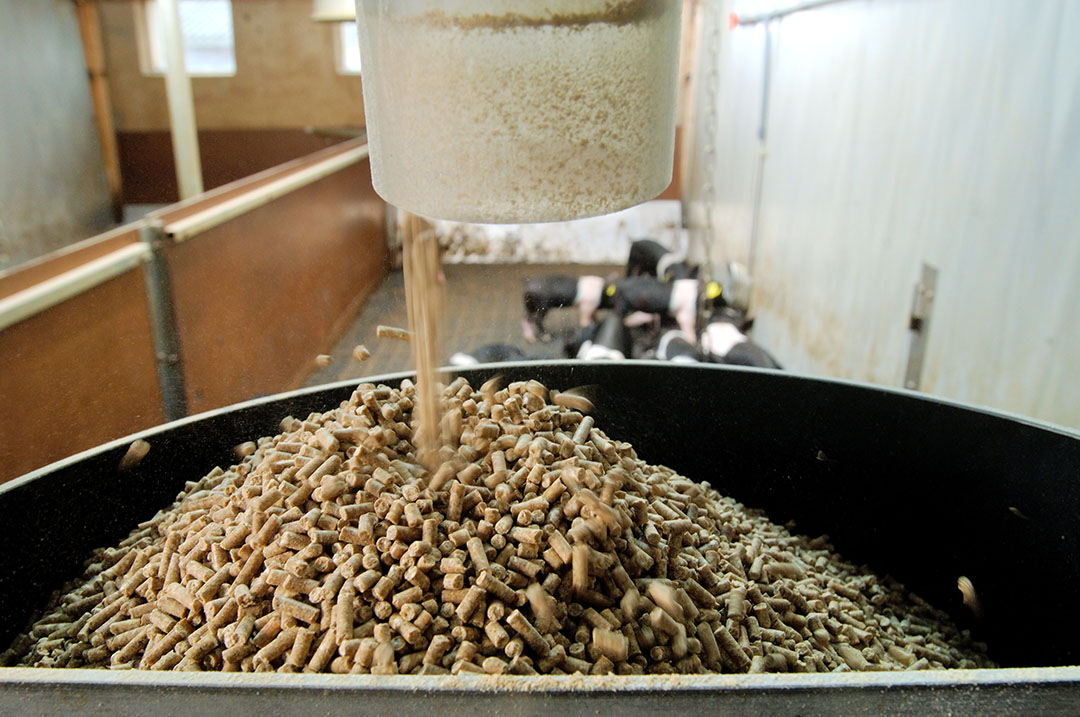
It was in 2014 that the North American veterinary community – as well as the worldwide feed and pork industries – started to realise that viruses were being transmitted in feed.
Porcine epidemic diarrhoea (PED) broke out in the United States in 2013 and by January 2014, the disease had arrived in Canada. “We figured out quite quickly at that point that the outbreak here in Canada was linked to a certain feed ingredient, from the same feedmill, and soon thereafter a research paper was published by scientists at the National Centre for Foreign Animal Disease in Winnipeg Manitoba that showed the link was possible,” explains Dr Egan Brockhoff, veterinarian at Prairie Swine Health Services in Red Deer, Alberta and veterinary counsellor for the Canadian Pork Council.
…more viruses survived in conventional soybean meal, lysine hydrochloride, choline chloride, vitamin D and pork sausage casings,” Dr Scott Dee.
“Then African Swine Fever (ASF) came along and since then in the US, Dr Scott Dee, Dr Megan Niederwerder and Dr Cassandra Jones and others have done a lot of work to look into how viruses can tag along in feed ingredients being shipped all over the world.”
 Track the movement of African Swine Fever
Track the movement of African Swine Fever
For everything you need to know about ASF, from the latest outbreaks to controls stay up to-date…
What’s been discovered about viruses in animal feed ingredients
Among the many other studies, Dr Dee (of Pipestone Applied Research at Pipestone Veterinary Services in Minnesota) and colleagues had published an evaluation in 2018 of the survival of livestock viruses in animal feed ingredients that were, and still are, imported daily into the US.
The study involved simulated transboundary shipping conditions and eleven diseases of global significance:
- Foot and Mouth Disease,
- Classical Swine Fever,
- African Swine Fever (ASF),
- Influenza A of Swine,
- Pseudorabies,
- Nipah,
- Porcine Reproductive and Respiratory Syndrome (PRRS),
- Swine Vesicular Disease Virus,
- Vesicular Stomatitis Virus,
- Porcine Circovirus Type 2 and
- Vesicular Exanthema of Swine Virus.
For 6 viruses, it was possible to use surrogates with similar genetic and physical properties but for the others, actual viruses had to be used. “We found that more viruses survived in conventional soybean meal, lysine hydrochloride, choline chloride, vitamin D and pork sausage casings,” says Dr Dee. “These results also supported data already published on the risk of transporting PEDv in feed.” By 2019, US Department of Agriculture scientist Dr Rebecca Gordon and her colleagues had published a review of studies published up to March 2018 (including the study by Dr Dee and his group) called ‘The Role of Non-animal Origin Feed Ingredients in Transmission of Viral Pathogens of Swine.’ In their analysis, Dr Gordon and her team concluded that whilst some critical questions pertaining to transmission of swine viruses via feed and feed ingredients have been addressed, further investigation is needed into how viruses are transmitted via feed to swine under actual field conditions. On that note, Dr Dee and his colleagues are preparing to publish results of a project where virus survival was tested by placing them in feed and driving the feed around the country for 21 days to simulate in-country transport conditions. The viruses used were PRRSv and PEDv and Senecavirus A, pathogens which Dee’s lab is certified to handle.
Awareness of how viruses survive in feed
Because of all the research into viral survival and transmission in feed since 2015, Dr Brockhoff says the world’s pork and feed industries have become very aware of how viruses can survive in and be transported in all sorts of different feed ingredients. “With my colleagues at the Canadian Pork Council (CPC), we went to the Canadian Food Inspection Agency (CFIA) with all the research in 2018, and we worked together to come up with changes in how high-risk feed ingredients such as unprocessed grains, oilseeds as well as associated meals destined for use in livestock were imported into Canada,” he explains. “Since March 2019, Canada has established import secondary control zones and permits for imports from countries with ASF, and the CPC has provided time and temperature recommendations for producers.” Dr Dee is happy to see that the CFIA took all the research seriously and has put many measures in place. “Here, the pork industry and feed industry have adopted some of the same measures,” he says, “but I would like to see a national government-led prevention and control programme to address viral disease presence and transport in feed, similar to what is in Canada.”
Managing the potential ASF threat in feed
Update on Canadian measures to properly import pig feed ingredients and on a US-based study into additives that reduce disease in pigs.
Using feed additives to destroy viruses
Building on findings showing virus survival in feed, scientists have been studying the capacity of feed additives to destroy viruses. Dr Dee and colleagues at South Dakota State University did a study of this in 2019 but it hasn’t been published yet. They found that titers of the four viruses tested (Senecavirus A, PEDv, PRRSv and Bovine herpesvirus type 1) were reduced by the presence of additives that contain a blend of medium chain fatty acids. Specifically, they found a strong anti-viral effect from a product containing a blend of organic acids and an analogue of the amino acid methionine (analogues of this amino acid, HMTBa and HMTBa-Ca, are authorised feed additives in the EU). At the start of May, Dr Dee and his colleagues also submitted a study for publication on the anti-viral effects of various commercial products on Senecavirus A, PEDv and PRRSv in feed. “There are several types of products,” says Dr Dee. “Some contain short, medium and long-chain fatty acids, organic acids either individually or in blends, and essential oils. A lot of these products are a blend of many things.”
Soybean-based feed ingredients protective of viruses
Looking at all the research that’s been done, Dr Dee says that on the whole, soybean-based feed ingredients such as soybean meal have consistently been found to be very protective of viruses. “We’re not sure if it’s due to the high protein content or another characteristic, but we in the US are still importing soybean meal from China, Russia and the Ukraine, which are all ASF-positive countries and that’s crazy,” he says. “In any ASF-positive country, there is the chance of cross-contamination through things like feed spilling on the ground and then being scooped up and bagged. Import of that particular ingredient from those countries should be stopped or a national programme like what Canada has, where this would be kept in a holding area and tested and treated, should be put in place. Yes, feed mills are doing this but we can’t be sure they are all doing this, and a national government-led programme would be best.” In Dr Brockhoff’s view, the most important thing feed mills can do to reduce risk of transmission of viral diseases through feed is, when possible, to buy ingredients from countries that aren’t infected with major diseases. “The Canadian pork industry right now has to import a variety of vitamins from China as we can’t get them anywhere else,” he says, “and it’s an extremely low-risk ingredient in terms of viral disease, but the packaging for anything can be a risk.”
How various additives inhibit viruses
Organic acids can directly inhibit virus activity, for example by suppressing gene expression. They can also prevent viruses from attaching to the surface of host cells. (In bacteria, organic acids are able to cross the membrane and cause disruption by changing the concentrations of charged atoms.) Fatty acids can affect the virus coating, causing leakage or total disintegration of the envelope. Some essential oils (e.g. eucalyptus, tea tree and thyme) can directly inactivate free virus particles.




